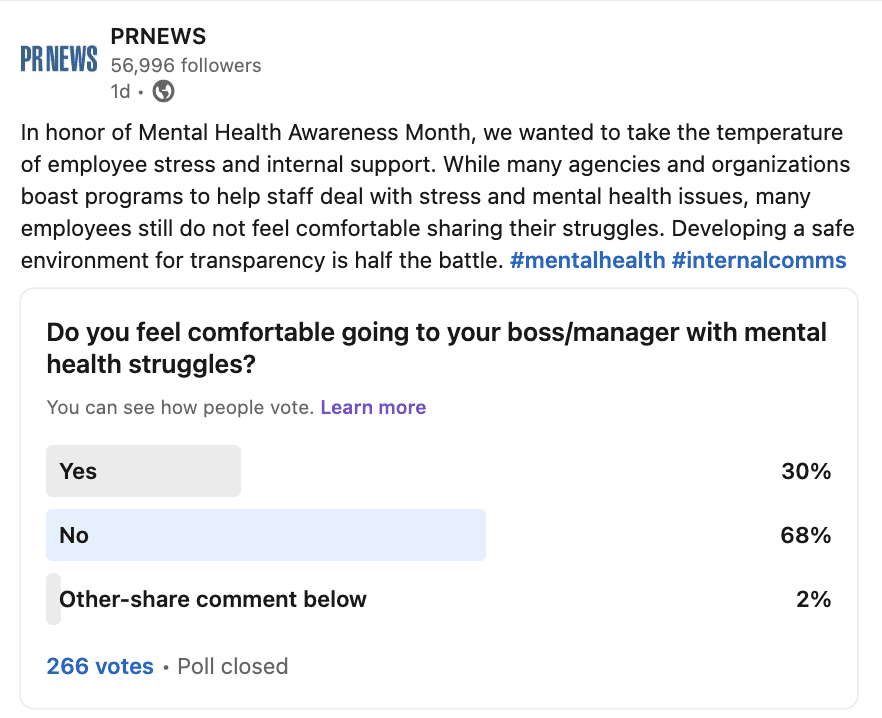
We’ve all been there. Long-term illness. Divorce. Family drama. Death of a friend or close relative. Overwhelming fear or panic due to a constant traumatic news state.
Stress affects all of us. And sure, work stress is one thing, but that becomes compounded by stress endured outside of the office. You never really know what anyone is going through. And organizations say they want to change that.
But saying and doing are two different things. You can provide tools for employees to alleviate, explore and treat mental illness, but if there is still a stigma or silence surrounding discussion of stress and mental illness in the office (or in remote relationships), the work really isn’t being done.
Sometimes people don’t feel comfortable voicing their struggles, or they just don’t have the strength to take advantage of a program or tool. They may suffer in silence. Their work output may decline. Personalities may become short or aloof. While a superior may think an employee no longer cares about their job, it could simply be burnout or something going on in their personal life, which is affecting job performance.
Do PR Employees Feel Comfortable Discussing Mental Health Struggles?
We continually say that for brand messaging to have an impact, you must walk your talk. The same goes for the inner-workings of organizations.
This week we reflected on Mental Health Awareness Month by asking our audience if they truly feel comfortable going to a superior about their personal struggles. The answers may surprise you.

As you can see here in our PRNEWS LinkedIn poll, a majority of 68% did not feel comfortable going to their superior with mental health struggles.
Just under a third, or 30%, said they did feel comfortable.
It Starts at the Top
Companies can provide mental health advocacy tools, but doing the work to build an environment where employees feel truly safe sharing their difficulties is key.
Mark Mohammadpour, founder and CEO, Chasing the Sun, a business that helps with employee empowerment in the family room and board room, says it all starts with training. Mohammadpour conducted his own LinkedIn poll of PR/comms professionals surrounding new people manager training. He says 57% of respondents responded they they don’t receive any formal training when put in management positions.
“We must first address this training gap to then address the gap in trust, especially in the remote/hybrid work era,” he says.
“Training should focus first on building trust and rapport, leading with empathy, and creating a safe environment for their teams,” Mohammadpour continues. “Because of the frequency of communication between managers and their employees, managers should also be prepared to discuss the company’s benefits and know when to partner with human resources to help their employees when needed.”
Training Communicators to Communicate
And it’s not just about training managers, but all employees on how to have these conversations. Many people did not grow up in environments conducive to expressing emotions or feelings.
Lisa Vasquez-Fedrizzi, Senior Vice President, People and Culture, LippeTaylor, says companies can play a role in facilitating conversation on mental health and well-being, something that should not only take place in May, but every day of the year.
“It’s not an easy subject to discuss, but I think giving employees the right tools and starters to feel comfortable with these conversations begins with HR,” she says. “Working with your employee assistance program to set up webinars or trainings for all employees on how to manage the conversation, facilitate the conversation and start the conversation is one of the best ways to start. By setting these up as an ongoing series, it shows that you are taking this seriously and are looking to create a safe space for [employees].”
Mohammadpour suggests allowing staff to visualize a supportive company environment by hosting workshops (on-site or virtual) and other real time conversations on mental health. However, he notes that these events can also be challenging to get people to open up. He relies on polling software and tools like Mentimeter to allow for anonymous answering to open-ended and multiple-choice questions.
Allowing Employees to Contribute
Taking the temperature of the company, by organizing and communicating with company ERGs, can also help organizations to understand the challenges of their work environment.
Vasquez-Fedrizzi suggests that the internal communications team work with a mental health ERG to find out what employees need and are looking for in terms of support.
“It can be holding monthly meet ups, creating confidential drop-in sessions or monthly newsletters with tips and resources, or it can just be as simple as sharing best practices for healthy styles of communication,” she says.
She says internal comms can work in conjunction with HR to promote these systems.
“All of these suggestions really come down again to the HR team and how they are communicating these options, their importance and showing empathy lets employees know they are safe and valued. When you show that there is a culture that is connected, it fosters gratitude and safety, and you are on the right road to showing that this is a safe environment for them to freely express themselves.”
Nicole Schuman is senior editor for PRNEWS. Follow her @buffalogal
